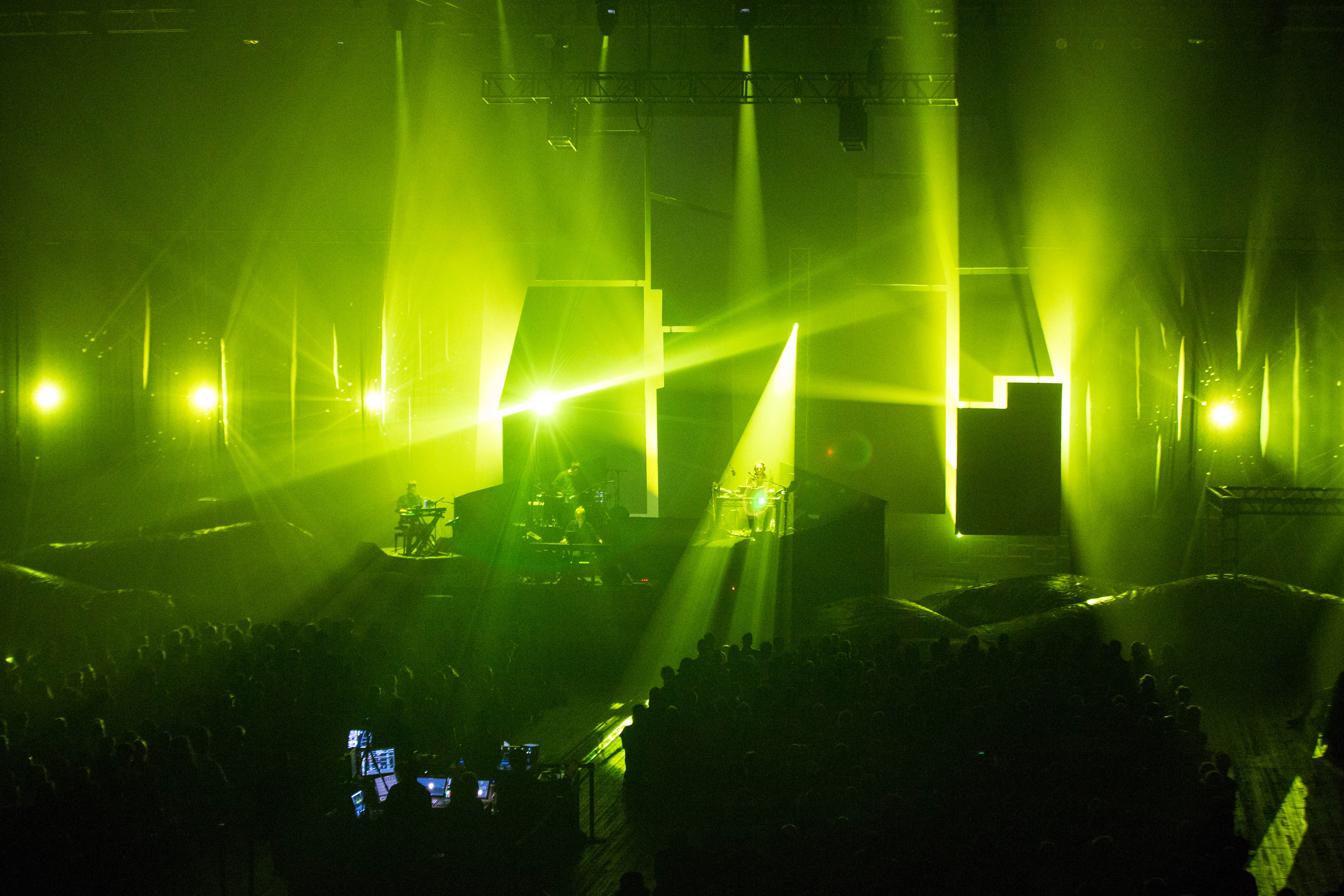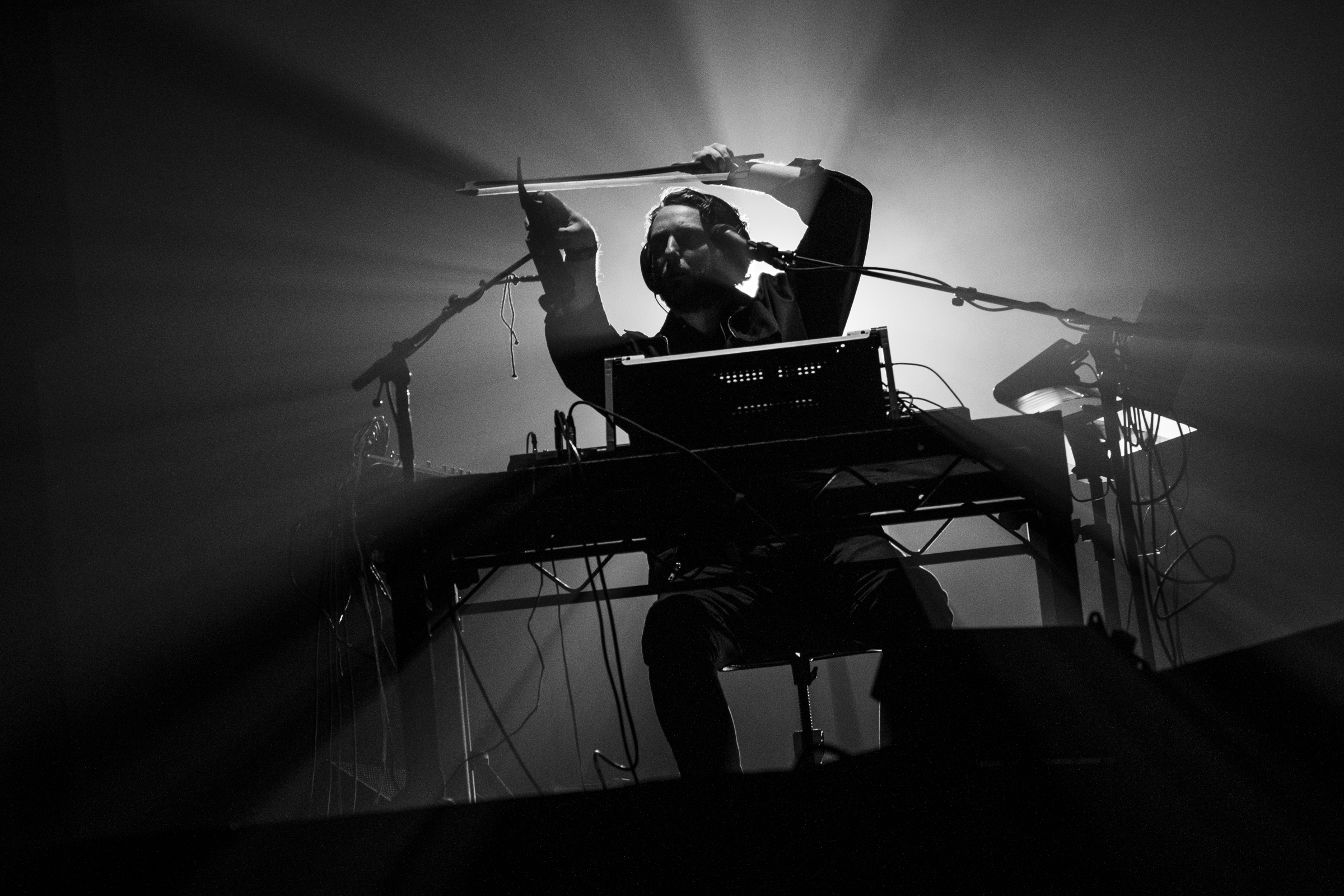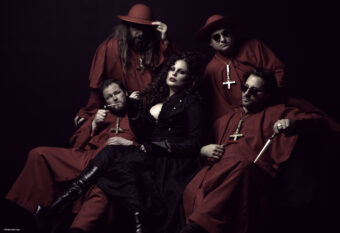At first, it was hard to identify the streaking blur of brown and gray pixels projected across the giant, irregularly shaped panels in Manhattan’s Park Avenue Armory. It dawned on me eventually, though: this animated creature was not “King Rat,” or even one of the chorus of “Various Rats.” Undoubtedly, this was “Thrash Rat.” The different rodents were listed among the Dramatis Personae in the splashy, intricately designed program–or “quasilibretto”–for Oneohtrix Point Never’s Myriad, a multimedia stage production expanding on the music included on the electronic composer’s upcoming ninth studio album, Age Of. Beneath the rat–and, after him, a expanded collection of other cartoonish demons–a quartet of musicians clad in black performed a clattering, mechanical dirge. This was “We’ll Take It,” a heavier Age Of track that recalls the noisier, industrial influences on OPN’s previous studio album, 2015’s Garden of Delete.
For these performances, staged as part of the Red Bull Music Festival in New York, Oneohtrix Point Never’s Myriad Ensemble is filled out by composer and keyboard virtuoso Kelly Moran, keyboardist and backing singer Aaron David Ross, and drummer Eli Keszler, whose feeds his free-jazz-like tattoos through disorienting delay and pitch-shifting patches. Traditionally, OPN is the solo project of 35-year-old Daniel Lopatin who–bearded, gleaming in a track jacket and chain–presides from the back of stage left, playing Vocaloid-drenched lead singer and stomping his feet vigorously.
Alongside the ensemble, huge, oblong tarps inflate gradually, forming a vaguely phallic landscape reminiscent of some barren planet from an episode of the original Star Trek. 300-pound sculpture-figurines light up, twirl, and spout delay-drenched jargon. At one point–in a Lynchian flourish–a troupe of dancers in leotards, wigs, and cowboy hats wrapped in Caution tape dance out-of-time down the aisles. Without putting too fine a point on it, it’s a wholly transportative live music experience. It demonstrates a staggering level of ambition even for Lopatin, who has become known for his high-concept stage shows.
***
When Daniel Lopatin and I met on a Sunday morning two days prior, he tried to explain what to expect from Myriad. “I wanted, like, OPN on Ice, OPN Fantasia,” he begins, grinning serenely and sipping from a Tupac coffee mug. Sitting in the lobby of his Greenpoint apartment building, we’re surrounded by mismatched future-ready furniture, a faux-Basquiat mural, and other coffee-table knick-knacks that emulate the decor of a tech startup’s office. The room scans like an earnest, physical emulation of some of Lopatin’s past avant-Muzak pastiches–say, the murmuring Windows-95-ready synths of 2013’s R Plus Seven.
Lopatin has just gotten back from 17 days of rehearsing Myriad at Rensselaer Polytechnic Institute’s state-of-the-art Experimental Music and Performing Arts Center in upstate New York, a facility to which he has sojourned to develop his ambitious multimedia tour stagings in the past. By his account, the process involved a bunch of “concentric crews working on different things”–the light show, the complex sound monitoring, the projections, the inflatables, and much more. The group will have one day of rehearsal in the Armory, and then be forced to dismantle the elaborate stage set between their Tuesday and Thursday shows.

He recalls the pitch he made for the extramusical concept of the show, which he summarized to his collaborative team of artists and stage designers as: “Use ornate set pieces, make real, or elucidate, formal themes blatant in the music for people who can’t hear them.” He continues: “I was interested in showing things to, like, my cousins, who may not have been sitting there listening to my music in detail or not considering the little intricate things that are happening in it. I got so excited by that idea…How do we illustrate vaguely formal characteristics of music?”
In terms of the specific aspects of the design, Lopatin has plenty of reference points ready at hand. The projection panels? Frank Stella’s Irregular Polygons. The light? Kubrick’s Barry Lyndon. The hanging figurines and grotesque cast of characters? Renaissance-era writer and scholar François Rabelais’ satirical five-part novel series The Life of Gargantua and of Pantagruel, centered around the puerile hijinks of a pair of giants.
Nearly 10 years since his breakthrough, Lopatin has never been closer to widespread recognition outside of the avant-garde and indie music circles in which he’s long been embraced as a visionary. Recently, he has been solicited for demos by Usher, collaborated with David Byrne, and won the Soundtrack Award at Cannes–and “powerful new agents”–for his work on the Safdie Brothers’ acclaimed arthouse action flick Good Time (Josh Safdie was in evidence at Myriad on Tuesday, taking photos and adding to his Instagram story in the aisle). Admirably, though, the music Lopatin is making on his own has never been more ardent and challenging.
More than any other album Lopatin has yet released, Age Of is guaranteed to make longtime fans reflect on how remote his current ethos feels from that of his breakthrough work–most crucially, his sprawling 2009 compilation Rifts, a collection of glacial synthscapes that is firmly situated in the ambient music tradition. Age Of begins with the most brazen possible assault on OPN’s former sensibilities. Harsh thwacks from a digital lyre precede a series of elaborate runs on an emulated harpsichord. These opening statements, which Lopatin claims introduce the musical themes for the entire album, recalls the dense and acerbic player-piano rolls of mid-20th-century avant-gardist Conlon Nancarrow. “Yeah, it’s the most irritating, kinda cloying, non-ambient thing possible,” Lopatin explains.
https://open.spotify.com/embed/track/5BOu8GAezoeEQPMKNCVmZ9
Age Of, which Lopatin finished in isolation in his home state of Massachusetts, is full of moments of this kind of demented baroqueness, but also makes plenty of detours into noise, New Age gauziness, and futuristic alt-pop. Its vocally-driven songs–on which he worked with James Blake–properly announce Daniel Lopatin the singer-songwriter, coupling the melodic floridity of modern R&B with a chunky, ominous atmosphere that is reminiscent of various ‘80s-pop experimentalists.
“The format of a ‘70s prog record was really inspiring,” he explains. “where you have [instrumental] suites and then these particular songs that are shorter, catchier bursts. There was a symphonic quality to the ratio of song to instrumentals being pretty even.”
Like many prog classics, Age Of combines a vague aura of pre-Enlightenment fantasy with an interest in sci-fi-like threads from our current day or age–the singularity, most importantly. Perhaps the most streamlined possible description of the “narrative” behind Age Of and Myriad is this: A post-apocalyptic group of A.I.s–to be exact, a “Limitless Living Informational Intelligence” which manifests itself as nine squares–is attempting to craft a history of human civilization, and we are listening to the fruits of their labor.
“These AI are the only things that really have all the answers–that can create new universes can do whatever,” Lopatin explains. “But instead of doing that, they kind of just loiter and chill around this dead Earth that’s no longer spinning that’s just a crusted up ball. They just dream of their ancestors and mothers and what it might have felt like to not have answers–to be stupid, essentially.”
Necessarily, the LLIIs’s primary source material is the Internet. Its vastness makes their attempts at nailing down a cogent timeline disastrous. Their transmissions are distorted by random ephemera and bursts of sonic chaos. “When they dream this dream, all they have is the sum of our recorded output,” he continues. “They are utilizing this stuff that makes no sense anyway–just a bunch of lies we tell about ourselves, or things that are true but don’t end up in history books or whatever. They end up in this dynastic cycle–this four act opera that they basically just replay over and over until the end of time.”
Lopatin often uses the term “epochs” to describe the four acts into which Myriad is divided. The word came from a short-lived book club with his friend and fellow MIDI mad scientist James Ferraro–based around reading Steve Bannon’s favorite books. First on the list was The Fourth Turning, by political pseudo-historians William Strauss and Neil Howe. The controversial book lays out a “generational theory” of American history based on recurring archetypes, and argues that, before 2025, a seismic “catastrophe” will occur in the United States that will drastically alter the course of human history (The book is also a favorite of Al Gore, who sent a copy to every member of Congress when it was released.)
“We tried to read that thing and it was totally psychotic,” Lopatin recalled. “It was like it was written from this really portentous point of view. It’s like self-help. That idea of being so sure of what has happened, and what will happen, is the most idiotic human thing that anyone can do.”
“It gets us in so much trouble, and there’s zealotry on all sides,” Lopatin continues, turning more serious. “There’s an arrogance of assuming that we can interpret the past–that we’ve left the right footnotes, that we’re doing the right reclamation projects, that we’re not overcorrecting. Actually, we have no idea where we’re going. It’s this Tower of Babel type scenario. Anything that’s too self-assured just makes me nervous.”
On the surface, the outlandish and periodically absurd Myriad might not come across like an inherently political work. But for Lopatin,one of its main intentions is to mock and explode the idea of oversimplified and manufactured historical “narratives”—a term which Lopatin uses pejoratively at multiple points in our conversation–and, by proxy, the “epochs” in Strauss and Howe.
“We have to be very careful about the narratives that kind of dominate us, and we kind of have to consider it to be as much of a comedy as anything else,” Lopatin explains.
***
Unpacking the themes and philosophy that inspired Lopatin over the past couple of years eventually leads to a discussion of a wide variety of films that factored into the development of this music. There’s 2001: A Space Odyssey (“the best film ever made”), Tim Burton (what you get “if you cross Spielberg and Lynch”) to Robin Williams movies (“One Hour Photo was insanely good”). The subject of Williams comes up in relation to Age Of’s queasily triumphant instrumental “Toys 2,” which imagines a world in which the 1992 Williams-starring black-comedic children’s film was granted a sequel.
“It’s inspired by Robin Williams’ estate saying specifically that he didn’t want his likeness to be represented in CG,” Lopatin explains. “I was blown away by that on so many levels. You feel like you’re on the edge of time when you hear something like that. But I also thought it was a genius move by a genius person. I thought ‘Oh, okay, cool, but I have a workaround. I’m just gonna make a piece of music that imagines Toys 2, with Robin Williams as a CG character.’”
Another pivotal Williams-related experience occurred more recently, during the development process for Myriad. Members of the show’s team had a group viewing of Steven Spielberg’s anomalous Peter Pan adaptation Hook, which Lopatin found “unbelievably inspiring,” at EMPAC. “Dustin Hoffman [as Captain Hook] is totally this kind of Trump guy,” he recalled. “He’s dipped in gold, he’s totally disconnected, he doesn’t understand anything until he kind of sees himself in it, and he’s being fed information through one very particular source.”
In the course of discussing Myriad and Age Of, it becomes clear how deeply essential film is to the project’s central invented philosophy, tied to an self-styled theory Lopatin calls “compressionism.” In some obscure blog post by an unidentified “Vietnam vet and teacher” (I can’t locate it anywhere), Lopatin came across a rough definition of the term: “returning language to its roots as image metaphor.” In the program to Myriad, Lopatin paraphrases the idea in an aside: “reduce music to its true metaphorical roots. Only an image-driven music can do these things.”
“That’s the way I think that music lives in people’s minds,” Lopatin explains. “I can’t tell you how much more important watching Hellraiser is to my music than listening to a Milton Babbitt piece or something.” (In Myriad, there is a moment when barbed-wire-covered ghouls reminiscent of the Cenobytes in Clive Barker’s 1987 horror film cameo on-screen.)
This is the point in our conversation at which Lopatin sounds most passionate, as if he’s hit on something central to the spirit of his composition. It seems as if an image-based and context-dependent view of musical concept—perceptible without “understanding” the technical aspects of the music—has an almost moral significance for him. He hopes consumers will to embrace their own individualism and freedom as listeners, and wants to eliminate barriers for entry into his often-challenging music.
“It’s all about grafting non-musical forms onto music to help understand the shapes that you’re hearing,” he continues. “It has really nothing to do with story, but…you’re getting to the way you see it, and the way you feel about it–something intrinsic to your subjective experience.”
***
Despite the depth of thought Lopatin seems to have put into his Myriad anti-narrative and its underlying philosophy, the unifying musical glue of the show and the album is pretty hard to distill. It’s all over the place. Lopatin cryptically describes the project as a “personal,” a concept he details further while discussing its vocal songs, sketching a loose canon of idiosyncratic singer-songwriter albums he loves. “I like records where it’s one person, who may or may not have a strong suit of some kind, who has to execute everything on their own,” Lopatin says. “I love hearing sound-on-sound layers of one person’s thinking about their music.” His favorite LPs made by freak geniuses include assorted works by Todd Rundgren and Stevie Wonder, a Numero-Group-reissued lost classic by former Buffalo Sabres defenseman Jim Schoenfeld, and Paul McCartney’s trash-compacted 1980 cult favorite McCartney II. “It’s so honest,” he says of Macca’s strangest album. “It just seems like he’s just unflappable…so stoned in his private moment.”
https://open.spotify.com/embed/track/5M1QuhhIwEqNXeNooLndH7
“Black Snow,” which features Anohni on backing vocals, is the catchiest and most straight-forward vocally driven song Lopatin has released to date. Ahead of Age Of’s release, it became the most streamed OPN song ever. It’s inevitable that we talk about Peter Gabriel, whose aesthetic imprint is all over Age Of (and plenty of the rest of the OPN catalogue), in relationship to the song, which features Security-reminiscent bleary high dramatics, percolating arpeggiators, and stark processed vocals. The track slowly builds from a spare, alien-sounding exposition dominated by Lopatin’s vocals toward a thick mist of synth counterpoint. “It’s a total Peter Gabriel thing,” he acquiesces. Lopatin’s reaction to the unexpected response to the song is a mix of gratification and bemused annoyance.
“Overall, it’s been amazing, but the repetitive register of criticism from the comment sections…it’s the most insanely weird approach to looking at music ever,” he says, sounding perplexed. “It always has to do with the first half versus the second half–’Well I don’t like the first half the second half is great.’ So, it’s a three and a half minute song, and you decided that the first half, where I’m basically just the narrator telling you important information–you can live without that and just get to the last minute. That’s enough information for me to finally feel like I just don’t care what people think.”
Lopatin’s objections here evidence a broader ambivalence toward the state of pop songwriting (“outside of Rae Sremmurd or whatever, I don’t really like anything that I hear on the radio–maybe Travis Scott”) and modes of music consumption in the streaming era. “People listen in such a way that you basically have 7 seconds to grab them,” he explains. “This is why I’m so surprised that [“Black Snow”] is on lists and it’s doing well. It feels like if you don’t hit someone with an 808 and a top-line hook of some kind you’re not at the table.”
It’s natural to wonder how far Lopatin, known for being hermetic, is interested in venturing into the pop music world. His recent work with Byrne, fka twigs, and Anohni seems to evidence his interest in applying his skill set to more traditionally song-based projects. From talking to him, it’s clear there’s a ideological barrier for entry, though it’s a bit difficult for him to describe it succinctly. “I’m basically looking for the equivalent of OPN in different mediums,” he muses. “That’s not about some sort of artistic athleticism, it just has to do with sort of enthusiasm and and ambition.”
At the very least, the preferred collaborative process of many artists is not something Lopatin feels like he generally works well with. “I don’t like having things calcified in other places with people I may or may not have discussed ideas with,” he says. “I don’t want to be invasively going through their stuff changing it, and then someone’s changing my thing, and there’s this domino effect of intrusion.” Lopatin claims that he felt some degree of “relief” when Usher, who is supposedly an OPN fan, ultimately chose to not use his demo for Age Of’s “The Station.” (“Jermaine Dupri meets the Books,” is how he explains it.) Generally, he seems alienated by the attitude of other artists toward the work they develop with bigger artists in mind, recalling the self-deprecating comments Grimes made around the release her 2014 single “Go,” a song the Canadian synth-pop artist originally penned with Rihanna in mind.
“She was like ‘this is my failed Rihanna song!’…I love her music so much, but I thought at the time I was like ‘Wait, are you saying this should have been a Rihanna song and it deserved to be?’ Because when I listened to it I was just like, ‘It’s a Grimes song!’”
The fact that Lopatin has the luxury to pick and choose his spots as much as he does is a testament to the enviable position he is in at this point in his career. Since his start in the early 2000s, has managed to merge a rich panoply of influences from avant-garde music with a quotient of populist appeal. Today, it seems like his fanbase will follow him to whichever extremes he goes to.
“I do think about the end user of the music, though,” he admits. “I find it ridiculous when I hear artists or musicians claim to not consider those things. I just think like, ‘Oh, that’s not really a person I would ever want to spend any time with. You don’t consider your audience, so you’re probably going to consider your friends, or your family, or anyone else.’”
***
Sitting in the Armory–tearing my eyes away from the Rat to squint and read ludicrous annotations in the program in the pitch black–it felt increasingly clear what a huge pivot Myriad was for Lopatin’s career. Both the show and Age Of illustrate a huge set of contrasts so elaborate that they are in danger of canceling each other out. They hold an optimistic, modernistic thrust, some cynical postmodernism, an obsession with centuries-old ornate stylization and fantasy tales, and a newfound interest in modern pop songform.
Lopatin intends his work to be a sprawling playground for listeners and concertgoers, providing a context in which any curious music fan can find something to be inspired or provoked by. “What I really like about style is that you don’t have to really believe in it,” is how Lopatin puts it to me. “You don’t have to live your life through it.”





